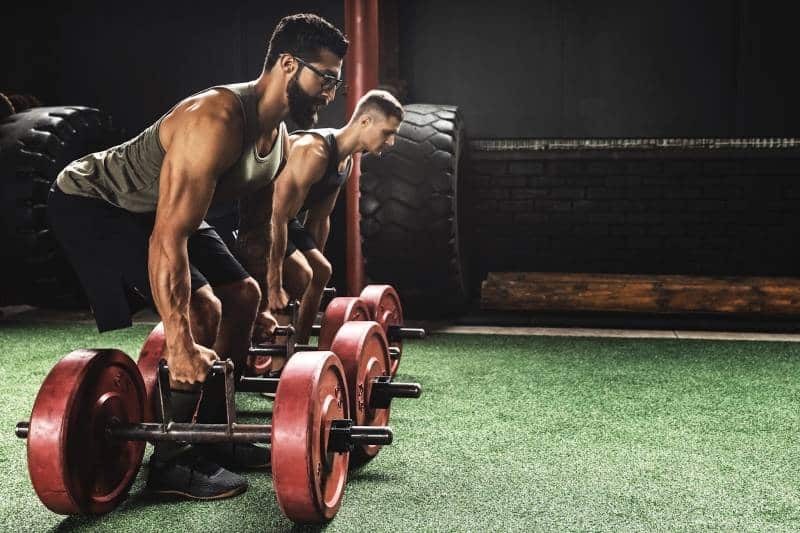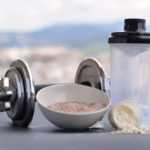If you’re looking to add a new cardio challenge into your workout routine, a full-body exercise like the farmer’s walk (also known as farmer’s carry) is a great starting point. This is one of the simplest yet one of the best exercises for boosting your overall body strength and fitness.
To execute it with a perfect form, get a pair of dumbbells loaded with weight plates and just stroll forwards. Balancing the dumbbells while walking around certainly requires a lot of coordination, grip strength, and core strength. Sounds easy? Sure. Is it actually easy? Not at all – especially if you do it with proper form.
Here’s an extensive how-to guide on executing the farmer’s walk properly along with the biggest benefits of walking it out.
Jump to:
What’s the Farmer’s Walk Workout?
The farmer’s walk, which is also known by the name farmer’s carry, is a strength and conditioning exercise that involves holding heavy weight in each hand while walking around for a particular distance.
This exercise targets most major muscle groups while also offering a great cardiovascular stimulus. Although it is very popular within strongman competitions, the farmer’s carry has also become a highly performed exercise by both athletes and recreational gym–goers.
This exercise can be easily added to your strength training sessions or it can be performed on its own as conditioning work. What’s more, this simple exercise is also a very functional movement as it directly applies to daily activities and works the same muscle groups, such as carrying groceries to and from the car.
How to Do the Farmer’s Walk Correctly?
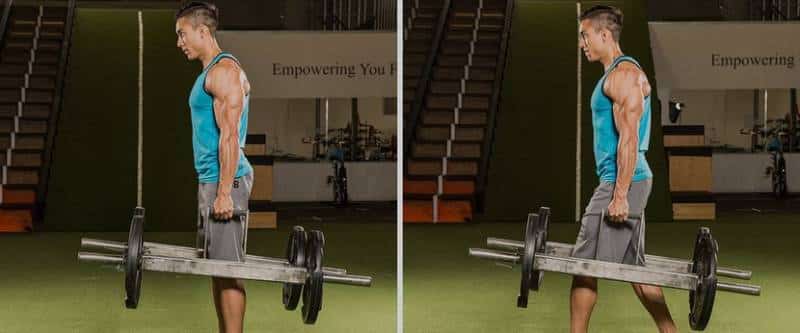
The farmer’s walk is a very simple and easy to perform exercise that can be done by most people, even with skill level in strength training. When first trying the movement, it’s recommended to start with lighter weights, carried on shorter distances and then to slowly pack on heavy load as your fitness level advances.
There are a few farmer’s walk variations, however, most beginners start with dumbbells thanks to their wide availability and ease of use. As your stamina and endurance advance, you can experiment with other dumbbell alternatives to make your walks more challenging.
What You’ll Need for the Farmer’s Walk
- dumbbells of different weights
- an available open space where you can walk at least 10 steps in a straight line
A Step-by-Step Guide for Perfect Form
- Begin by choosing dumbbells in the proper weight for your fitness level and put them on the floor on both sides of your body.
- Then, reach down bending at the hips and knees, and take the dumbbells in each hand.
- In a deadlift manner, extend your hips and knees all while maintaining a neutral spine position.
- Hold the dumbbells at your sides with a firm grip. Stand tall and keep your shoulders, back, and core strong and tight.
- Start moving by walking forward at an even pace. Keep your sight straight ahead of you and focus on executing the exercise correctly.
- After you finish the number of steps you planned, stop and slowly put the weights down, all while keeping your spine in a neutral position and a tight core.
- After that, make sure to rest for no longer than 1–3 minutes and repeat the exercise until you reach the wanted number of sets.
Although the goal of this exercise is not to complete the steps as fast as you possibly can, as you start lifting heavier loads, it’s natural for your steps to become shorter and quicker. Yet, this study suggests that, as you progress in skill, keeping a consistent stride length and boosting your stride frequency can significantly enhance peak performance and results
To avoid injury while doing the farmer’s carry, remember to keep a straight spine throughout the entire movement and do not use heavy dumbbells if you don’t feel ready just yet.
What Muscles Does a Farmers Walk Work?
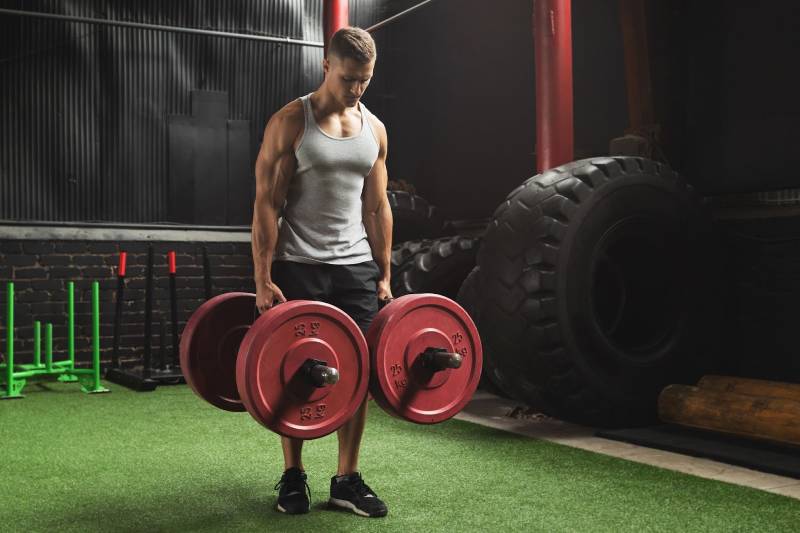
The farmer’s walk is an entire body exercise that helps you build body strength and muscle endurance over time. However, when doing it, some muscle groups are targeted more than others, thanks to the nature of its movement pattern.
Quads
The quads, or quadriceps are the ones responsible for knee extension. They help you lift the weights from the floor, help start your forward movement as well as stabilize and balance the knee joint throughout the entire movement.
Hamstrings
The hamstrings are the muscle group responsible for hip extension and knee flexion. They play a major role in deadlifting the weights from the floor, lifting the legs for each step, and stabilizing the hip and knee joints.
Glutes
The three gluteus parts – the gluteus maximus, medius, and minimus are primarily responsible for extending the hip joint. They play a vital role in deadlifting the dumbbells from the floor and greatly help stabilize the hip joint throughout the whole exercise.
Calf muscles
The calves are the lower leg muscles which help balance the ankle joint while performing the farmer’s walk.
Lats
The lats are the biggest back muscles and they are responsible for keeping a neutral spine and good posture while performing farmer’s walks.
Erectors
The erectors are also known as paraspinal muscles and they surround the spine, helping in the spinal extension and core stabilization while doing farmer walks.
Upper Back and Traps
The trapezius muscle, also known as traps as well as the upper back muscles help strongman training to establish and maintain a tall posture while doing the farmer’s walk. They do this by retracting the shoulder blades up and back. Decent shoulder stability is crucial for to perform this exercise.
Abdominals
The abs, or abdominal muscles are responsible for keeping the core tight while performing this exercise, all while simultaneously protecting the spine.
Biceps
The biceps muscles are the ones enabling arm flexion and they also help you develop a strong grip. When doing the farmers walk, the biceps help you to tightly grip the dumbbell and stabilize the elbow joint.
Triceps
The tricep muscles are the ones that provide arm extension at the elbow joint. When doing the farmer’s walk, they keep your arms straight and work together with the biceps to help stabilize your arms.
Forearms and Hand Muscles
The complex muscles of the hands and forearms play an essential role in your grip while doing the walk exercise. They help you to tightly and securely grasp the dumbbells throughout the movement.
Farmer’s Walk Benefits
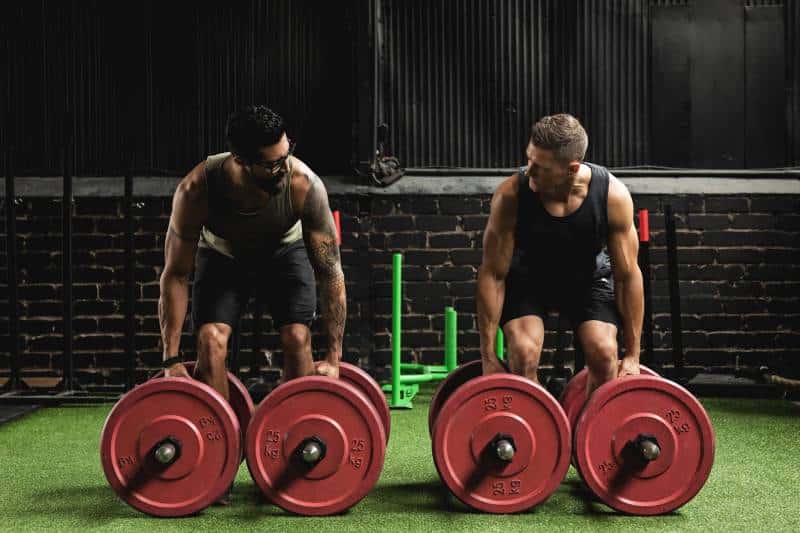
The farmer’s walk is a full body exercise that involves carrying heavy objects and has several potential benefits.
Improves Endurance and Cardiovascular Health
Although it may seem very easy to perform, the farmer’s walks is a demanding exercise that will have you breathing heavily. It is a high intensity exercise that increases aerobic capacity, all while reducing the risk of cardiovascular diseases such as heart attacks.
What’s more, your aerobic capacity is an indicator of your level of performance in various endurance sports, such as cycling, running, swimming, and cross country skiing. People with a higher aerobic capacity are able to sustain higher performance levels for a longer period of time.
Boosts Muscle Strength
Wondering do farmers walk build muscle? To execute farmer’s walks, you need to engage all your body muscles, which, in turn, helps you build muscle and boost functional strength. The upper back, lats, traps, forearms, quads, hamstrings, and glutes are the most targeted muscles when doing the farmer’s walks.
This exercise is also very effective at enhancing stronger grip strength, as it’s essential to tightly hold the weights while doing this movement. Adding the farmer’s walks as a part of your training routine can help boost your performance in other sports such as basketball, football, baseball, tennis, etc.
Farmer’s Walk Variations
After you have mastered the dumbbell farmer’s walk, you might want to experiment with some other, more challenging variations.
The Kettlebell Carry
This exercise is very similar to the dumbbell carry, but instead of dumbbells, you use kettlebells. The bigger handle diameter of the kettlebell makes this exercise a bit harder to perform, which makes it a great progression towards the more challenging farmer’s walk variations.
Farmer’s Walk Handles
This is the original way of performing the farmer’s walk and it’s usually used by competitive weightlifters. The farmer’s walk handles are much bigger than dumbbells, meaning they enable you to add significantly more weight. You need a lot more technique to perform the farmer’s walk handles variation because as you move, the handles tend to tilt back and forth, requiring more dynamic strength.
Trap Bar Carry
Named by its trapezoid shape, the trap bar is a specialty barbell typically used to perform deadlifts. This means it can be loaded with weight and used to perform the farmer’s walk. The trap bar carry exercise is a bit easier to perform than the farmer’s walk handles since the center of gravity is more balanced and there’s no shifting like there is with the handles.
Suitcase Walk
The suitcase walk is a one-handed farmer’s walk that can be done with a few different implements. With the suitcase carry, you pick only one weight from the floor and carry it a particular distance.
To execute the suitcase walk properly, you need significantly more belly muscles’ strength and stabilization to remain upright, since the heavier weights tend to pull you to one side.
Rickshaw Carry
The rickshaw is a unique piece of equipment that’s usually used by advanced weight lifters. It’s very similar to a trap bar, however, instead of the weight plates touching the ground, the rickshaw features a metal frame that only contacts the ground.
This farmer’s walk variation provides a bit more stability than the trap bar during the lifting part of the movement but it’s a bit more unstable during the walking part.
FAQs: Farmer’s Walk
What exactly is the farmer’s walk?
The farmer’s walk is a functional strength exercise where you hold a heavy weight (like dumbbells, kettlebells, or specially designed implements) in each hand and walk for a set distance or time.
Why is it called the “farmer’s walk”?
It’s named after the age-old activity of farmers carrying heavy buckets of water or feed across their fields—a testament to its functional roots.
What muscles does the farmer’s walk target?
While it primarily targets the core muscles, grip strength, and shoulders, nearly every muscle in your body, from the calf muscles to the traps, gets engaged during this exercise.
How does it benefit daily activities?
By improving grip strength and core stability, the farmer’s walk can enhance your ability to carry groceries, lift heavy objects, and maintain a better posture in day-to-day tasks.
Can beginners try the farmer’s walk?
Absolutely! The beauty of the farmer’s walk is its scalability. Start with lighter weights and shorter distances and progress as your skill level improves.



